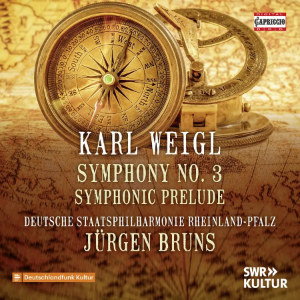
Karl Weigl (1881-1949)
Symphony No 3 in B-flat major (1931)
Symphonic Prelude to a Tragedy (1933)
Deutsche Staatsphilharmonie Rheinland-Pfalz/Jürgen Bruns
rec. 2021, Philharmonie, Ludwigshafen, Germany
Capriccio C5489 [63]
Like many other musicians of Jewish heritage, Vienna-born Karl Weigl was forced to flee Austria in 1938, following the Anschluss. He lived out his life in America, teaching and composing.
Weigl worked under Mahler at the Vienna Court Opera. His music was tonally conservative: he refused to bow to the slowly increasing hegemony of Schoenbergian serialism. His first symphony, one of six, was premiered in Zürich in 1910 with considerable success. His symphonic style represented in Symphony No 3 is not particularly strong on memorable melody, but his orchestration is at times imaginative and interesting. That, and a noticeable contrast between movements, make this work a nice listening experience.
The first movement begins in a curiously gruff, somewhat jerky manner. The lowest strings are initially given the spotlight, and then the brass plies a more prominent role. As the first minute or so of the work progressed, I began to think that Weigl was portraying the sound of a large steam engine slowly gathering pace as it left a station. This soon morphs into a quiet horn-led interval, where a gently soaring violin takes us back to a brief reminiscence of the opening. A brief brass-dominated climax is reached, which by the beginning of the fourth minute becomes quietly lyrical; flute twittering is supported by strings and clarinet, suggesting spring. But Weigl cannot let his brass rest. Once more they come to the fore, only to be replaced again by the flute. By this time, I was beginning to wish that he settle down and give the orchestra (and listener) a chance to assimilate his themes. In the case of the woodwind and strings, a more extended acquaintance would have been enjoyable. By eleven minutes, the opening theme is reintroduced, but this time played in a more flowing tempo with brass tending to lead. I expected a definitive climax to be achieved, but no, within seconds we are back in a pastoral musing mode. The movement continues in this fragmented vein until the last thirty seconds, when it manages to accelerate to another repetition of the opening theme.
Repeated listening had allowed me to recognise the constituent themes, and the initial rather chaotic impression of this movement faded. It left me with a wish that Weigl had felt able to make more extended use of his material, with fewer transitions from one theme to the next.
The slow movement, at some seventeen-and-a-half minutes, perhaps unsurprisingly gives us a similar treatment of its material. The booklet refers to the block-like arrangement of themes in the work, and goes on to claim that it is one of the most beautiful of Weigl’s slow movements. Well, I think that he is prepared to wear his heart on his sleeve, and to repeat over and over again the very short main theme, initially presented on strings and woodwinds with gentle horns in support. Yet it is not a memorable theme. He does eventually bring it to a full orchestral climax at 10:16 and again at 11:45. The subsequent wind-down surprises by girding its loins to yield a major but brief climax at 14:11. There follows a gradual descent into silence, permeated by repeating the main theme.
I have listened a few times, and I really think that Weigl would have been better advised to await a more memorable inspiration, rather than rely to such a degree on a dull two-or-three-bar phrase.
The third movement starts briskly and proceeds in a seemingly erratic manner, with themes tossed to-and-fro; reminiscences of the earlier movements put in an appearance. Any relaxation is momentary, and eventually this shortest movement comes to a brief climactic ending.
The filler is the sixteen-minute Symphonisches Vorspiel zu Einer Tragödie. It was composed in relation to the play Wunder von Verdun, which tells of a fantastical vision: fallen World War I soldiers appear and relate their stories. The work immediately reminded me of the outer movements of the 3rd symphony, and so left me unmoved.
Weigl never heard his symphony or the Vorspiel performed.
The reader will have gathered that I am not unduly impressed. The performances are pretty good, but the unanimity of the Rheinland-Pfalz orchestra strings is strained several times in the symphony’s first movement. I wonder whether a more flowing presentation of the rather jerky parts of the first and last movements might have impressed me more. There are slim chances of this work or the Symphonisches Vorspiel being recorded by a crack orchestra. On this showing, I am not surprised that Weigl’s music is rather neglected.
The recording is fine, with the reservations noted above, and so is the orchestral playing. The booklet notes in German and English give biographical and musical details of Weigl and his music.
Jim Westhead
Buying this recording via a link below generates revenue for MWI, which helps the site remain free




















